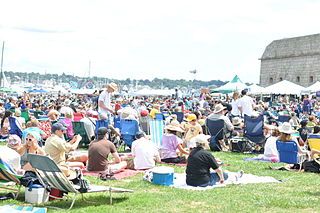From Guest Blogger Kimbriel Dean: Festivals Around the World Turning to Green Energy

Since festivals are temporary in nature and often take place in isolated rural locations, the challenges of setting up clean power sources are quite different compared to most permanent commercial or residential projects. Festivals typically consume an enormous amount of fuel to power the generators. Since the cost of fuel is high, switching to sustainable power sources can save event producers money.
Right now, there are many examples of small to medium festivals (under a capacity of 20,000 people) that are entirely powered by renewable and WVO (waste vegetable oil) biodiesel solutions. In the UK, examples include Croissant Neuf, London Green Fair, Shambala and Sunrise Celebration.
In the U.S., Lightning in a Bottle is an excellent example of a festival that’s doing their best to reduce their environmental impact through energy choices. Their first priority is to make sure they’re as energy efficient as possible. Then, as much as possible, they maximize their use of renewable energy fuel sources, including biodiesel and solar. Biodiesel runs their light towers, generators, camping shuttles, and crew vehicles. They provide a solar cell phone recharging station for attendees to use. Since they haven’t yet been able to completely cover their energy needs through renewable sources, they offset emissions through certified carbon offsets, focusing on projects that are as local as possible and verified by the Climate Action Reserve (CAR).
Green Energy Options for Outdoor Events
What are the green energy choices available to event organizers? To some extent, it depends on event location and local suppliers. When suppliers aren’t able to offer renewable energy choices, it’s a good idea to ask them to do so.
By choosing the most energy efficient options available like LED lighting for stages, a 100% sustainable power event becomes a more realistic goal.
Here’s a list of potential power options:
Solar power
Solar generators have been used to power small to medium stages for many years. For events or areas where quietness is required, solar generators offer silent power.
According to The Green Festival Alliance’s “The Power Behind Festival”s report, Glastonbury Festival (UK) and Melt! Festival (Germany) have installed permanent renewable systems on their sites. Large solar arrays generate power which is fed back into the national grid all year round on FITS (Feed in Tariffs), as well as supplying some power during the event. This type of setup can provide a year round income, becoming profitable once the installation costs are returned.
Wind power
Since wind power systems are vulnerable to weather (wind), there aren’t many temporary wind power systems available on the market for events, even though they are commonly used for road signs, boats and off-grid living. However, there are a handful of successful small scale suppliers on the festival circuit who combine solar and wind.
Diesel and Waste Vegetable Biodiesel Generators
Diesel and biodiesel are widely used at festivals and outdoor events. It’s important to be careful with the source of biodiesel. For example, virgin biodiesel made from palm oil cultivated in clear-cut rain forests and peat forests causes up to 2,000 percent higher greenhouse emissions than fossil fuels, according to the 2009 United Nations Environment Program report on biofuels.
Waste vegetable biodiesel comes from used cooking oils and is a good environmental choice. It may not be available in the quantities needed for big events.
Pedal power
Like wind power, bicycle pedal power translates kinetic energy through dynamos into electricity. At festivals, pedal power is used to charge phones, cinemas, sound and lighting, and interactive art installations. The power from all bicycles is aggregated, and batteries are generally used to store it.
Dance Power
The Sustainable Dance Floor uses dancing as an energy source. The energy produced by movement is converted into electricity which can be used to power local systems such as LED-lights. It works because the dance floor is designed to compress when people step on it, and this compression activates a generator. While it doesn’t produce enough power to make much of a dent in festival energy needs, it can be a fun way to get people excited about the possibilities held by green energy.
Hybrid
Most green events use a combination of these options, based on particular festival needs and local availability.
Festivals provide exciting opportunities to educate diverse segments of the population on the promise and potential of renewable energy options. For those who are interested in learning more about opportunities in renewable energy for events, the annual Green Events & Innovations conference “allows the festival community, academics, suppliers, scientists, sponsors and other interested parties to come together and share ideas and highlight any developments within their sector or at their events.”
What’s your experience with green energy at festivals? Please tell us about it!
About the author: Kimbriel Dean is a writer for Ignite.me, a site dedicated to sustainability, consciousness and culture.
